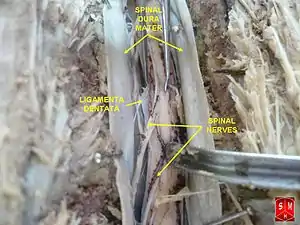Dural ectasia
Dural ectasia is widening or ballooning of the dural sac surrounding the spinal cord. This usually occurs in the lumbosacral region, as this is where the cerebrospinal fluid pressure is greatest,[1] but the spinal canal can be affected in any plane.[2]
| Dural ectasia | |
|---|---|
 | |
| Spinal cord | |
| Specialty | Neurology |
Signs and symptoms
Most common symptoms include lower back pain,[2] headaches,[2] weakness,[2] numbness (anesthesia) above and below the involved limb,[2] leg pain,[3] and sometimes there can be rectal[2] and genital pain.[2] Bowel and bladder dysfunction, urinary retention or even incontinence may occur. [4]
The symptoms are usually exacerbated by upright posture and often but not always relieved by lying down. However, in many patients it is asymptomatic.
Causes
It is common in Marfan syndrome,[3] occurring in 63–92% of people with the syndrome.[5] Dural ectasia may also occur in Ehlers-Danlos Syndrome,[1] neurofibromatosis type I,[1] ankylosing spondylitis,[1] and trauma.
In neurofibromatosis type I it has been theorized that local infiltration of the dura by plexiform neurofibromas leads to a weakening of the dural allowing the outpouching. A retrospective study found that a majority of dural ectasia were associated with nearby plexiform neurofibromas. [6]
Treatment
Dural ectasia can be asymptomatic, in which case no intervention is necessary. However, it is associated with chronic pain in patients with Marfan syndrome, suggesting it is a structural risk factor [7] There is no medical consensus on how to manage symptomatic (painful) dural ectasia. The majority of patients are treated conservatively with pain control medications, physiotherapy, and other physical modalities, with often incomplete control of patients' pain. [8] [9]
Though various websites on the internet report that acetazolamide can be used to treat dural ectasia in individuals with Marfan Syndrome, the only supporting evidence for this assertion exists from a small study of 14 patients which was not peer-reviewed or submitted for publication.[10][11] Moreover, several published cases of intracranial hypotension related to Marfan syndrome would warrant caution in using acetazolamide in these patients unless there is a clear indication, as it could lower intracranial pressure further. [12]
References
- Liu, CC; Lin, YC; Lo, CP; Chang, TP (June 2011). "Cauda equina syndrome and dural ectasia: rare manifestations in chronic ankylosing spondylitis". The British Journal of Radiology. 84 (1002): e123-5. doi:10.1259/bjr/45816561. PMC 3473624. PMID 21606066.
- Altman, A; Uliel, L; Caspi, L (March 2008). "Dural ectasia as presenting symptom of Marfan syndrome" (PDF). The Israel Medical Association Journal : IMAJ. 10 (3): 194–5. PMID 18494231.
- Shirley, ED; Sponseller, PD (September 2009). "Marfan syndrome". The Journal of the American Academy of Orthopaedic Surgeons. 17 (9): 572–81. doi:10.5435/00124635-200909000-00004. PMID 19726741.
- Nallamshetty, L; Ahn, NU; Ahn, UM; Nallamshetty, HS; Rose, PS; Buchowski, JM; Sponseller, PD (August 2002). "Dural ectasia and back pain: review of the literature and case report". Journal of Spinal Disorders & Techniques. 15 (4): 326–9. doi:10.1097/00024720-200208000-00012. PMID 12177551.
- Lacassie, HJ; Millar, S; Leithe, LG; Muir, HA; Montaña, R; Poblete, A; Habib, AS (April 2005). "Dural ectasia: a likely cause of inadequate spinal anaesthesia in two parturients with Marfan's syndrome". British Journal of Anaesthesia. 94 (4): 500–4. doi:10.1093/bja/aei076. PMID 15695549.
- Polster SP, Dougherty MC, Zeineddine HA, et al. Dural Ectasia in Neurofibromatosis 1: Case Series, Management, and Review. Neurosurgery. 2020;86(5):646–655. doi:10.1093/neuros/nyz244
- Ahn, Nicholas U.; Sponseller, Paul D.; Ahn, Uri M.; Nallamshetty, Leelakrishna; Kuszyk, Brian S.; Zinreich, S. James (June 2000). "Dural Ectasia Is Associated With Back Pain in Marfan Syndrome". Spine. 25 (12): 1562–1568. doi:10.1097/00007632-200006150-00017. PMID 10851107. S2CID 7459589.
- Foran, Jared R. H.; Pyeritz, Reed E.; Dietz, Harry C.; Sponseller, Paul D. (2005). "Characterization of the symptoms associated with dural ectasia in the Marfan patient". American Journal of Medical Genetics Part A. 134A (1): 58–65. doi:10.1002/ajmg.a.30525. PMID 15690402. S2CID 23015722.
- Polster SP, Dougherty MC, Zeineddine HA, et al. Dural Ectasia in Neurofibromatosis 1: Case Series, Management, and Review. Neurosurgery. 2020;86(5):646–655. doi:10.1093/neuros/nyz244
- to http://www.spineuniverse.com/displayarticle.php/article922.html https://web.archive.org/web/20070926233505/http://www.spineuniverse.com/displayarticle.php/article922.html to http://www.spineuniverse.com/displayarticle.php/article922.html Check
|archive-url=value (help). Archived from to http://www.spineuniverse.com/displayarticle.php/article922.html the original Check|url=value (help) on 2007-09-26. Missing or empty|title=(help) - {{cite web|(2020).author=Farzam, Khashayar, and Muhammad Abdullah |title="Acetazolamide." StatPearls [Internet])
- Cheuret, E.; Edouard, T.; Mejdoubi, M.; Acar, P.; Pienkowski, C.; Cances, C.; Lebon, S.; Tauber, M.; Chaix, Y. (1 April 2008). "Intracranial hypotension in a girl with Marfan syndrome: case report and review of the literature". Child's Nervous System. 24 (4): 509–513. doi:10.1007/s00381-007-0506-3. PMID 17906865. S2CID 5734726.